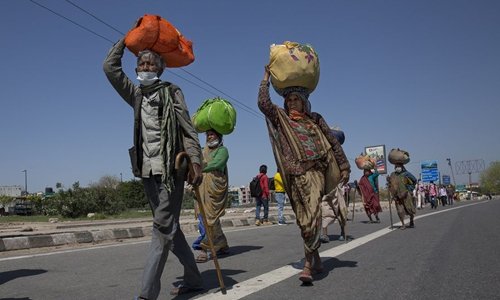The global impact of the COVID-19 pandemic has been unprecedented in its sheer scale and spread. The fallout of the virus has been extremely severe for emerging economies like India. With a view to flattening the virus curve and containing its community transmission, the Government of India imposed an almost 2-month nationwide lockdown leading to factory closures, supply chain disruptions and a massive economic slump.
More than 400 million workers or approximately 90 percent of India’s workforce is employed in the informal sector of the economy.
This socio-economic group broadly comprises migrants, manual laborers and sanitation workers who earn daily wages and are based at the bottom of the economic pyramid. COVID-19 has disproportionately impacted this category of workforce and placed them at a greater risk of being pushed into extreme poverty. The economic crisis brought on by the pandemic and the ensuing extended lockdown has technically pushed them into the ‘new poor’ category.
If we were to observe the mega stimulus package of Rs 20 lakh crore rolled out by the government, it looks at bolstering the supply side of the economy. It has been lauded for measures like refinancing of loans to vendors and providing credit risk guarantees to exporters.
The stimulus initiative should also have focused on boosting the demand side of the economy. It should have facilitated direct cash injection at the bottom of the pyramid. The process of economic revival cannot be kick-started and expedited unless the workforce belonging to the ‘new poor’ category is financially strengthened and rehabilitated.
In order to jumpstart the demand side of the economy, a structured approach needs to be initiated by addressing 6 key drivers which are diversified across 3 categories.
Hardware
Migrant workers who come to cities from villages in search of work do not have access to sustained shelter solutions. They do not have a house to call their own. Workers and their families who have been stranded in cities across the country on account of the COVID-19 induced lockdown should be provided with temporary or transitional shelters. Infrastructural interventions in the form of such shelters will not only provide them safety and security but will also play an enabling role in the containment of the COVID-19 virus.
There is also a need to identify COVID-19 hotspots especially in urban slum areas with high population density. Following the identification of such areas, COVID-19 care centers should be set up to isolate asymptomatic patients from low income families. As asymptomatic patients are potential carriers of the deadly novel coronavirus, their isolation can greatly help in preventing the community transmission of the pandemic.
Software
It is necessary to put cash in the hands of people from the lower income groups and the ‘new poor’ so they can buy food and other daily essentials. This can be achieved by providing them with conditional cash transfers (CCT) for food and rental subsidy. To revive the economy at the bottom of the pyramid, the onus should be on promoting community enterprises and social enterprises through cash plus skills and restarting Micro Finance Institution (MFI) activities.
Self Help Groups (SHGs), NGOs and other community stakeholders need to leverage their collective expertise and resources for helping build financial resilience among communities from lower income groups.
Women from the unorganized sector in Kerala who had lost their jobs in the lockdown phase were provided training and offered material support to manufacture COVID-19 masks under the ‘Kudumbashree’ State Poverty Eradication Mission in Kerala. These masks are being purchased by the Government through bulk orders. This has not only provided the women with livelihood opportunities but also helped them become self-reliant.
Women can form groups and raise loans from MFIs to form community enterprises and run small business ventures. Profits generated from these businesses can be distributed among the women. The central government has allowed people living in poor condition in rural areas comprising of small farmers, landless laborers and laborers who returned to their villages during the lockdown to take up work under the MGNREGA scheme and given them opportunity to earn fixed wages.






